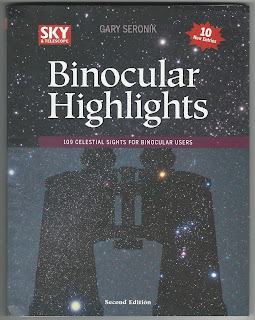Binoculars are easy to carry. The images in the very wide field of view are correct vertically and horizontally. Without a tripod (or monopod), you will steady them as best you can, seated with your elbows on your knees. And, even so, some of your targets will be overhead, so those solutions remain inoperative. Nonetheless, the advantages outweigh the difficulties.
(Submitted to Sidereal Times of the Austin Astronomical Society.) As with telescopes, bigger is better, up to a limit of convenience. The author warns that the impressive views of larger instruments require a heavy-duty mount and tripod. That said, even a small set will reveal celestial sights unavailable to the naked eye – which is the point of viewing with any instrument. Binoculars deliver broad and wide vistas of deep sky clusters and nebulae.
 |
| Binocular Highlights: 109 Celestial Sights for Binocular Users, 2ndEdition,by Gary Seronik, Sky & Telescope, 2017, 112 pages +4 fold-out maps, $24.99. |
Seronik explains the optics. He also clarifies the parameters of the instruments. A pair of 10x35 are 10 power with a 35-mm objective lens. On the frame, you will likely find another measure. My 12x45 Bushnell (purchased from the close-out aisle at Walmart for $39.95) say 225 FOV at 1000 yards. However, my little Vivitars ($29.95 retail), which I measured as 30mm, keep all of their secrets. Seronik does discuss the latest computer-driven image-stabilizing options, but only briefly. His heart is with “The Allure of Cheap Binoculars.” The reason why is that the optics are usually a given. It is a known technology. Better, more expensive products have sturdier mechanics: they take travel well and stay tight over time.
If you have the first edition, and have been active with it you probably do not need the new printing. As far as I can tell, comparing page by page, the only differences are the ten new objects. If you have been out often with your “binos” since 2010, then you may well have penciled them in on your own.
Among the new targets is Albireo, which should be on everyone’s list. Others, such as NGC 2243 and NGC 2345 in Monoceros and M56 in Cygnus are going to be a challenge even with 50 mm objectives, except under ideal conditions. Also among the additions are the open clusters Cr 132 and Cr 140 in Canis Major. They may stand out for you because of their relative brightness, +3.6, but it may be hard to resolve them better than points of light. Even so, the thrill of the hunt is one of the strongest motivators that we astronomers enjoy.
PREVIOUSLY ON NECESSARY FACTS

